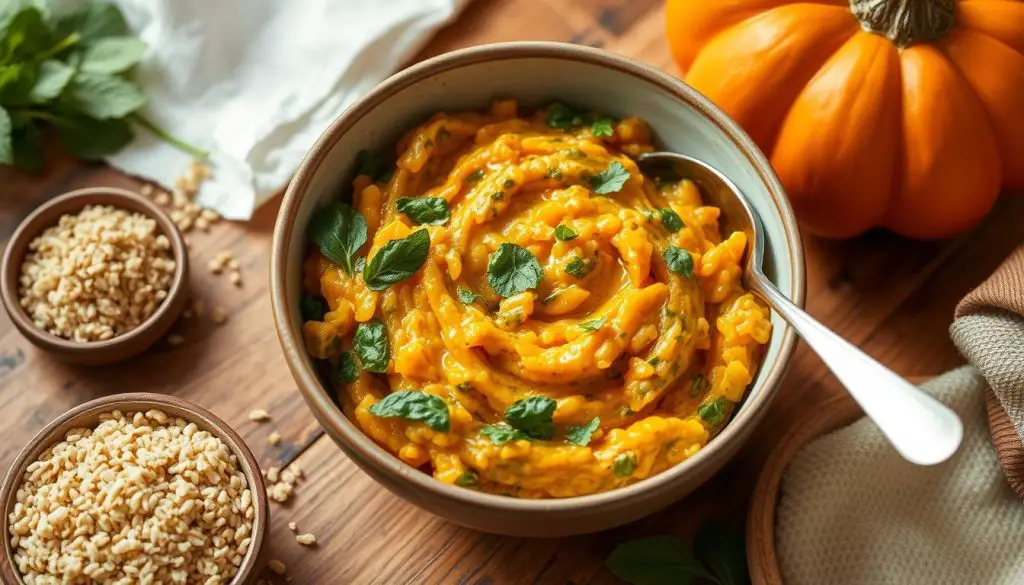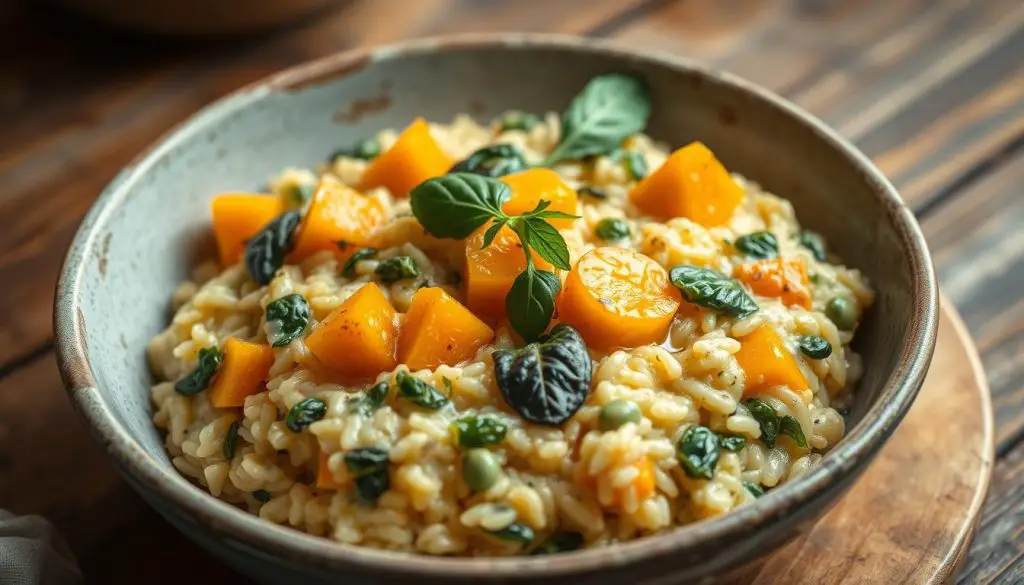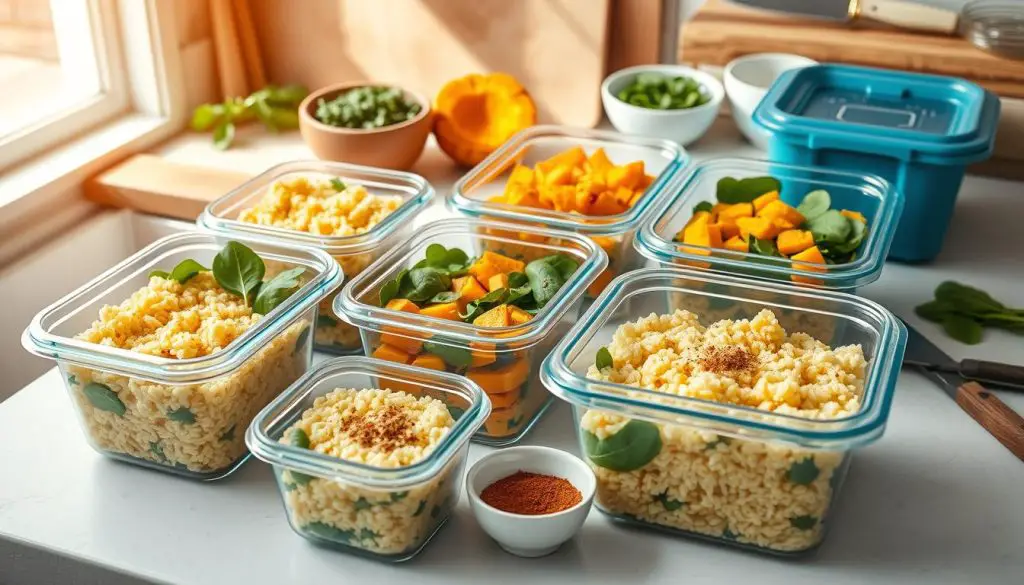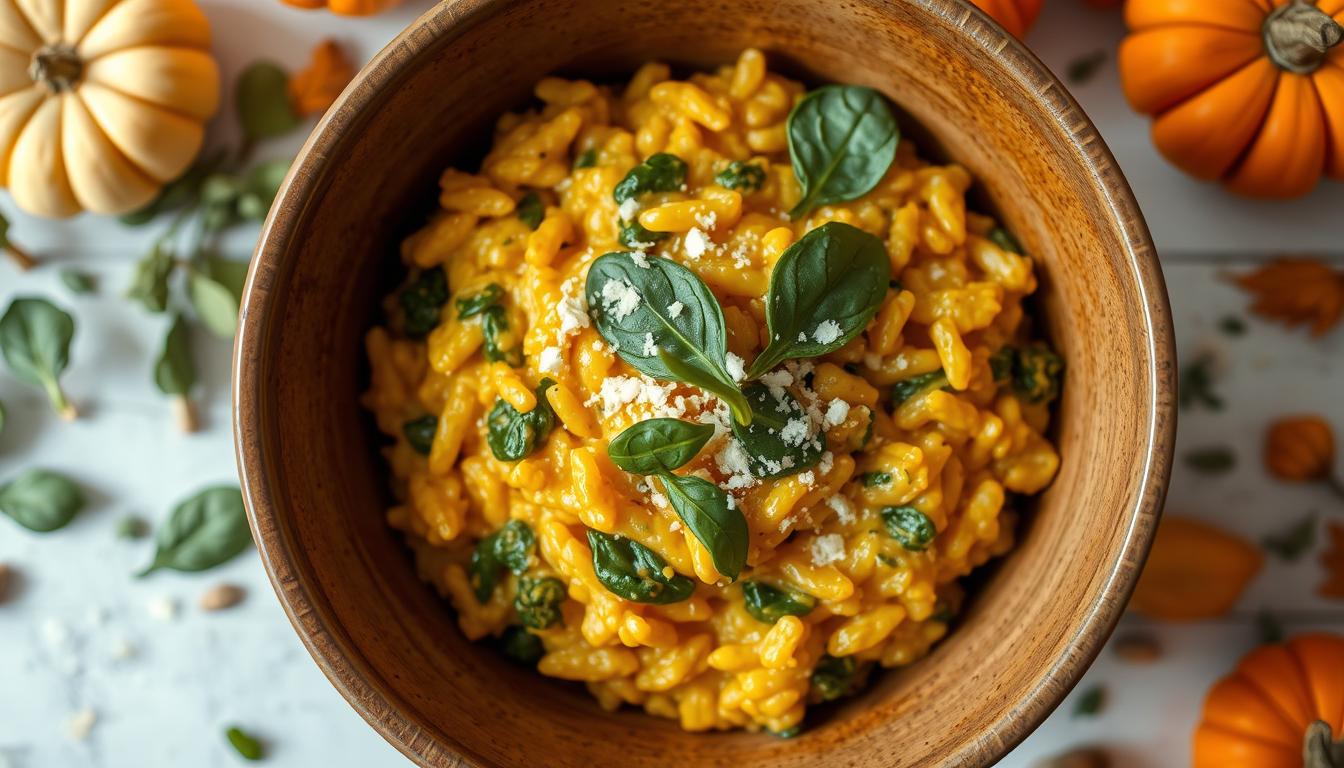Have you ever thought about how food might help with fibromyalgia? Studies show that the right diet can really help with chronic pain and fatigue. Pumpkin is a big hit in the fibromyalgia world.
Pumpkin is full of good stuff like vitamins A and C, and fiber that’s good for your gut. It can even help reduce inflammation and improve physical performance. These are big wins for fibromyalgia sufferers.
We’re thrilled to share this tasty Pumpkin and Spinach Risotto recipe. It’s a comforting dish that’s good for fibromyalgia. It’s time to explore the healing power of whole foods and take control of your health.
What is Fibromyalgia and How Can Diet Help?
Symptoms and Diet’s Role in Managing Chronic Pain
Fibromyalgia is a complex condition with widespread fibromyalgia symptoms like pain, fatigue, and sleep issues. The exact causes are not known, but an anti-inflammatory diet helps manage symptoms. This is key for those with chronic pain.
People with fibromyalgia feel pain more easily, often a dull ache all over. Stress, activity, and some foods can make it worse. Eating an anti-inflammatory diet can help reduce inflammation and ease fibromyalgia symptoms.
Fibromyalgia also brings overwhelming fatigue and poor sleep. A good dietary management plan can help. It gives the body what it needs and improves sleep and energy.
Adding foods like fatty fish, berries, and leafy greens to your diet is helpful. Avoiding processed and sugary foods is also important. A well-thought-out anti-inflammatory diet can be a big help. Working with healthcare professionals, you can create a diet plan that improves your life.
The Benefits of Pumpkin and Spinach for Fibromyalgia
If you have fibromyalgia, what you eat matters a lot. Pumpkin and spinach are great for your health.
Pumpkin is full of antioxidants like beta-carotene. These help fight inflammation and stress, common in fibromyalgia. It also has lots of fiber for better digestion and gut health.
Spinach is rich in anti-inflammatory nutrients like magnesium and vitamin C. These can ease fibromyalgia pain and muscle tension. Spinach also has folate for nerve health.
Adding pumpkin and spinach to your diet can really help. They are anti-inflammatory foods that can reduce pain and improve your life.
| Nutrient | Pumpkin | Spinach |
|---|---|---|
| Vitamin A | Yes | Yes |
| Vitamin C | Yes | Yes |
| Magnesium | Yes | Yes |
| Fiber | Yes | Yes |
| Antioxidants | Yes | Yes |
Adding pumpkin and spinach to your fibromyalgia diet is a smart move. They offer many health benefits and can help manage symptoms. By using these foods, you can improve your health and well-being.
Anti-Inflammatory Ingredients in This Risotto Recipe
This pumpkin and spinach risotto is full of ingredients that fight inflammation. It’s not only tasty but also good for your health. The mix of pumpkin, spinach, garlic, and onions is rich in antioxidants. These are key in reducing inflammation, which is common in fibromyalgia.
Pumpkin is a great source of beta-carotene, a strong antioxidant. Spinach, with its vitamins, minerals, and plant compounds, also fights inflammation. It has lutein and zeaxanthin, which are good for you.
How Antioxidants and Fiber Contribute to Gut Health
The antioxidants and fiber in this risotto are also good for your gut. Fiber helps with digestion and supports good gut bacteria. It also lowers gut inflammation. The antioxidants in pumpkin and spinach protect the gut and help keep it healthy.
This pumpkin and spinach risotto is a nourishing meal for those with fibromyalgia and other chronic conditions. It’s packed with nutrients that help fight inflammation and support gut health.
Why a Gluten-Free Risotto is Ideal for Fibromyalgia
If you have fibromyalgia, a gluten-free diet might be key. Studies link gluten sensitivity to more inflammation, which worsens fibromyalgia pain. Avoiding gluten could help reduce gut inflammation and control symptoms.
This pumpkin and spinach risotto recipe is gluten-free. It’s perfect for those with fibromyalgia. Without gluten, your body can focus on healing and managing pain without digestive issues.
- A recent Italian study found a high rate of insulin resistance (79%) in patients with fibromyalgia.
- Some doctors suspect that hypocortisolism (low cortisol level) is underdiagnosed in chronic fatigue syndrome.
- Basmati rice (long-grain) has a glycemic index of 57, while Arborio or risotto rice (medium grain) has a glycemic index of 69.
- Baked potatoes have a very high glycemic index of 85, contributing to a quick rise in blood sugar levels.
Choosing a gluten-free risotto avoids gut inflammation. It also has a lower glycemic index. This helps keep blood sugar levels stable, which is vital for those with fibromyalgia and insulin resistance.

Everyone’s body reacts differently to food. Paying attention to how foods affect you is key. If gluten sensitivity is a concern, talk to your doctor about testing or an elimination diet. Making smart food choices can help manage fibromyalgia and improve your health.
Nutrient-Dense Whole Foods for Energy and Vitality
Managing fibromyalgia symptoms can be tough. But, eating nutrient-dense whole foods can help a lot. These foods give you essential vitamins, minerals, and antioxidants. They also boost your energy and well-being.
Adding these foods to your diet supports your body’s healing. It can help reduce chronic pain and fatigue from fibromyalgia.
Boosting Micronutrients for Overall Well-being
The pumpkin and spinach risotto recipe is full of good stuff. Pumpkin is loaded with vitamin D. Vitamin D is key for immune function, bone health, and pain relief.
Spinach is a nutrient powerhouse. It’s full of vitamins, minerals, and antioxidants. These help fight inflammation and support cell health.
Eating these foods can improve your energy and vitality. It’s a big step towards better well-being with fibromyalgia. Even small diet changes can make a big difference in your life.
To make this risotto even better, try adding other foods good for fibromyalgia. For example:
- Onions – rich in antioxidants and anti-inflammatory compounds
- Garlic – a potent source of allicin, which can help reduce inflammation
- Spices like turmeric, ginger, and black pepper – known for their anti-inflammatory properties
By choosing these foods, you make a meal that nourishes your body. It supports your well-being and helps manage fibromyalgia symptoms.
Step-by-Step Guide to Making Pumpkin and Spinach Risotto
Making a tasty pumpkin and spinach risotto is a great way to enjoy a meal that’s good for fibromyalgia. Follow these easy steps to make this comforting dish at home:
- First, get all the ingredients ready: arborio rice, vegetable broth, canned pumpkin, fresh spinach, onion, garlic, olive oil, parmesan cheese, and spices like salt, pepper, and thyme.
- In a big saucepan or Dutch oven, heat the olive oil over medium heat. Add the onion and garlic, and cook until they’re soft and smell good, about 5 minutes.
- Put the arborio rice in the pan and stir to coat it with oil. Cook the rice for 2-3 minutes, stirring often, to make it taste nutty.
- Start adding the warm vegetable broth, a little at a time, stirring constantly. Keep doing this until all the broth is used up. This makes the rice creamy.
- When the rice is tender but not too soft, add the pumpkin and spinach. Cook for 5-7 more minutes, until the spinach is soft and the pumpkin is mixed in well.
- Take the pan off the heat and mix in the parmesan cheese. Add salt, pepper, and thyme to taste.
- Put the pumpkin and spinach risotto in a bowl and serve it warm. You can add extra parmesan, olive oil, or herbs on top if you like.
This guide will help you make a delicious and fibromyalgia-friendly pumpkin and spinach risotto at home. Enjoy this nourishing dish as part of your diet to help manage chronic pain and support your overall health.

Pumpkin and Spinach Risotto for Fibromyalgia
For those with fibromyalgia, finding meals that comfort and nourish is key. The pumpkin and spinach risotto in this article is perfect. It’s made with anti-inflammatory ingredients and is gluten-free.
This risotto combines pumpkin and spinach for a great taste and health benefits. Pumpkin and spinach help reduce inflammation. The garlic and onion add to the dish’s anti-inflammatory effects, easing muscle and joint pain.
This dish is not just good for pain relief. It’s also very nutritious. Pumpkin is full of vitamins A and C, and antioxidants. Spinach is rich in vitamins, minerals, and fiber, helping with digestion and gut health.
The gluten-free nature of this risotto is a big plus for fibromyalgia sufferers. Some studies show that a gluten-free diet can lessen pain and inflammation. This means your body can focus on healing instead of fighting inflammation.
If you’re looking for a comforting meal or want to add anti-inflammatory foods to your diet, try this risotto. It’s a great choice for managing fibromyalgia symptoms. Enjoy this delicious dish on your path to better health.
Discover more fibromyalgia-friendly recipeson Fireweed.
Customizing the Recipe for Personal Dietary Needs
The pumpkin and spinach risotto recipe is great for those with fibromyalgia. It’s also easy to change to fit different diets. Whether you’re vegan, vegetarian, or have other dietary needs, you can adjust this dish to meet your requirements.
Vegan and Vegetarian Alternatives
For a vegan or vegetarian version of the pumpkin and spinach risotto, you can make the following substitutions:
- Instead of chicken or vegetable broth, use a plant-based broth or water.
- Replace the Parmesan cheese with a vegan or vegetarian cheese alternative.
- Omit the butter and use a plant-based oil, such as olive oil or coconut oil, for sautéing the vegetables.
These simple swaps will allow you to enjoy the same delicious flavors and textures of the risotto while adhering to your vegan or vegetarian dietary needs. You can also add extra vegetables or legumes to make it even healthier and more to your liking.
| Ingredient | Vegan/Vegetarian Substitution |
|---|---|
| Chicken or Vegetable Broth | Plant-based Broth or Water |
| Parmesan Cheese | Vegan or Vegetarian Cheese Alternative |
| Butter | Plant-based Oil (Olive, Coconut) |
By making these simple substitutions, you can enjoy the pumpkin and spinach risotto while catering to your specific dietary needs and preferences. Remember, the key is to experiment and find the right balance of flavors and textures that work best for you.
Meal Prepping and Batch Cooking for Fibromyalgia
Living with fibromyalgia can make meal prep tough. But, with some planning, you can save time and eat well. Meal prepping and batch cooking the pumpkin and spinach risotto can really help.
Preparing big batches of risotto means you can reheat it easily. This is great on bad days when cooking feels too hard. Just store it right, and you can quickly have a healthy meal.
Think about making more than you need. This way, you can have extra risotto for the rest of the week. Meal prepping and batch cooking are big time-savers for those with fibromyalgia or other chronic illnesses.

Also, you can make the recipe fit your diet better. Try different veggies, spices, or even make it vegan. It’s all about finding what’s best for you.
By making big batches of risotto, you have a quick, healthy meal ready. This can reduce stress and fatigue from meal planning. It’s a big help for those with fibromyalgia.
Serving Suggestions and Complementary Dishes
There are many ways to serve your pumpkin and spinach risotto. This dish is creamy and comforting. It goes well with many foods, making meals better for those with fibromyalgia. Try it with a fresh green salad for a nice contrast and extra antioxidants. Roasted veggies like carrots, zucchini, or asparagus also add fiber and nutrients.
For a fuller meal, pair the risotto with gluten-free bread or toasted quinoa. These options are rich in fiber, making the meal more filling. They’re great for those with fibromyalgia looking for nutritious meal ideas.
Adding a protein-rich element like grilled chicken, sautéed tofu, or tempeh bacon can enhance the meal. These additions boost the nutritional value, ensuring a balanced and serving suggestions that meets your body’s needs.
The pumpkin and spinach risotto is very versatile. Try different complementary dishes to find what you like best. By mixing various nutrient-dense foods, you can make a meal that’s both tasty and good for you.
Fibromyalgia-Friendly Kitchen Tips and Tools
Preparing meals can be tough for those with fibromyalgia. Fatigue, pain, and limited mobility make cooking hard. But, the right tools and techniques can make it easier and more fun. Check out some fibromyalgia-friendly cooking tips and kitchen tools for easier chronic illness meal prep.
An Instant Pot or slow cooker is a great investment. They cook for you, saving you time and effort. Just add your ingredients, set the timer, and let it work its magic. This is a big help for fibromyalgia-friendly cooking, as it cuts down on the need to stand and stir.
- Use ergonomic utensils, like thick-handled knives and spoons, to ease hand fatigue during prep.
- Get a good food processor or blender to make chopping and pureeing easier on your body.
- Try a vegetable spiralizer to turn veggies into noodle shapes, adding variety to your chronic illness meals.
Meal prepping is also a smart strategy. Spend time on weekends or when you’re not in pain to prep meal parts. This can mean chopping veggies, cooking grains, or making casseroles ahead of time.
| Kitchen Tool | Benefit for Fibromyalgia |
|---|---|
| Slow Cooker | Minimizes hands-on time and physical exertion |
| Ergonomic Utensils | Reduces hand fatigue during food preparation |
| Food Processor | Streamlines chopping, dicing, and pureeing tasks |
By using these fibromyalgia-friendly cooking tips and tools, you can make meal prep easier and more enjoyable. Taking care of your body and simplifying tasks helps a lot in supporting your well-being.

Sharing this Comforting Risotto with Loved Ones
Preparing a meal like pumpkin and spinach risotto can bring people together. It’s a way to connect and build a supportive community for those with chronic illness. Cooking and sharing a meal can create empathy and strengthen bonds.
Building Community Around Chronic Illness
Living with fibromyalgia means having a supportive network is key. Sharing meals with friends and family can fight off feelings of loneliness. It’s a powerful way to connect.
- Invite loved ones to help cook, teaching them about your dietary needs.
- Plan a “fibromyalgia-friendly” potluck where everyone brings a suitable dish.
- Host a dinner party focused on a nourishing meal and good conversation.
These moments can deepen your loved ones’ understanding of your condition. It fosters empathy and strengthens your support network. By involving them, you build connections and a sense of community around your illness.
Remember, sharing meals does more than feed our bodies. It nourishes our souls too. Use these moments to build a community of support and understanding on your fibromyalgia journey.
Exploring More Anti-Inflammatory Recipes
This pumpkin and spinach risotto is just one example of an anti-inflammatory recipe. It’s great for people with fibromyalgia. By trying more dishes with whole foods, you can help your body and find new favorite meals.
There are many anti-inflammatory recipes out there. You can make hearty soups, tasty salads, and roasted veggies. Add foods rich in omega-3s like salmon and walnuts. Also, include fruits and veggies with antioxidants, like berries and leafy greens.
Try new recipes and change ingredients to fit your diet. Enjoy the process of making your body healthy. A diet full of anti-inflammatory foods can help you manage fibromyalgia. Start this journey and see how it changes your life.
Source Links
- https://sevenlayercharlotte.com/2018/11/01/notes-from-the-gluten-free-dairy-free-class/
- http://www.healthfooddesivideshi.com/2016/05/beetroot-juice-can-become-your-best.html
- https://www.healthline.com/nutrition/low-glycemic-diet
- https://www.healthline.com/health/ulcerative-colitis/what-vegetables-can-i-eat-with-ulcerative-colitis
- https://www.medicalnewstoday.com/articles/321683
- https://www.healthline.com/health/crohns-disease/nutrition-guide
- https://www.linkedin.com/pulse/what-eat-improve-dna-methylation-part-1-dr-alexander-jimenez-
- https://unboundwellness.com/nightshades/
- https://www.simplyquinoa.com/anti-inflammatory-ginger-turmeric-carrot-soup/
- https://nourishingmeals.com/search?updated-min=2016-01-01T00:00:00-08:00&updated-max=2017-01-01T00:00:00-08:00&max-results=12&search=&page=33
- https://www.healthrising.org/blog/2013/09/23/glycemic-index-diet-right-chronic-fatigue-syndrome-fibromyalgia/
- https://glutenfreeeasily.com/the-spin-on-spelt/
- https://dokumen.pub/the-autoimmune-solution-cookbook-over-150-delicious-recipes-to-prevent-and-reverse-the-full-spectrum-of-inflammatory-symptoms-and-diseases-0062853546-9780062853547.html
- https://www.yumpu.com/en/document/view/65059585/foods-that-harm-and-foods-that-heal-pdfdrive-
- http://lifeafterbread.co.uk/page/2/
- https://restormedicine.com/wp-content/uploads/woocommerce_uploads/2023/06/ebook-dbjlbc.pdf
- https://www.throughthefibrofog.com/cooking-chronic-illness/
- https://www.fireweedacupuncture.com/recipes
- https://www.perskyfarms.com/phpBB/viewtopic.php?t=20609
- https://happyherbivore.com/blog/archive/
- https://www.runsforcookies.com/search/label/vegan?max-results=20&m=0
- https://thediscerningyou.com/chronic-illness-cooking-tips/
- https://soapdelinews.com/2019/12/mushroom-bacon-risotto-recipe-winter-dinner-idea-heart-healthy-bacon-alternatives.html
- https://alignedmodernhealth.com/site-map/
- https://www.aol.com/see-white-stuff-salmon-means-123701504.html#!
- https://www.avogel.co.uk/health/skin/eczema/diet/
- https://chrismasterjohnphd.com/what-chrismasterjohn-does/2018/06/22/what-i-eat/
- https://www.meritageresort.com/things-to-do-napa-valley-blog
